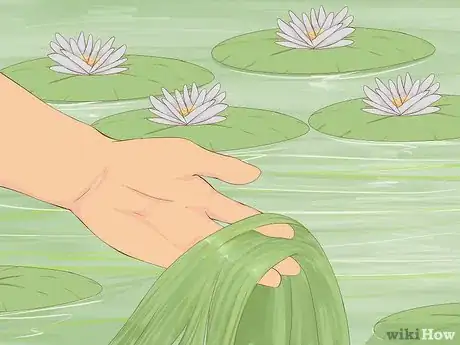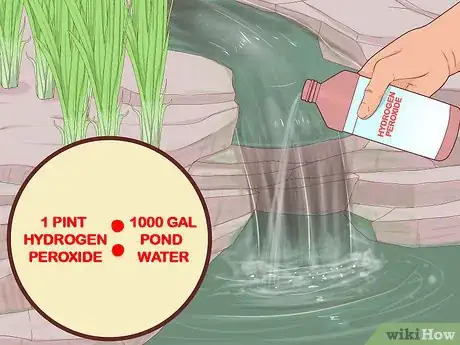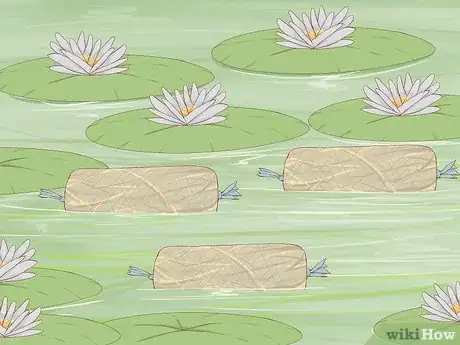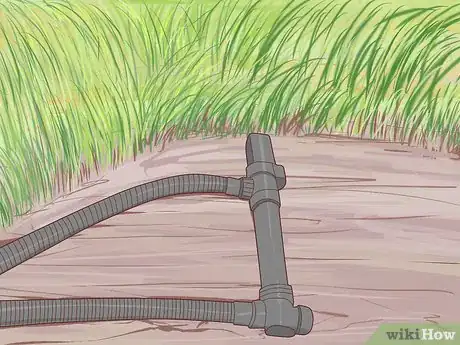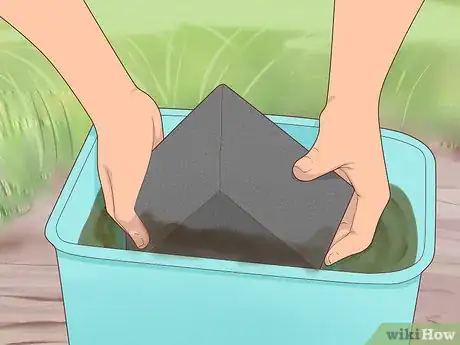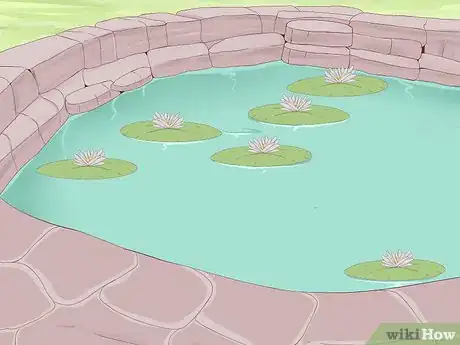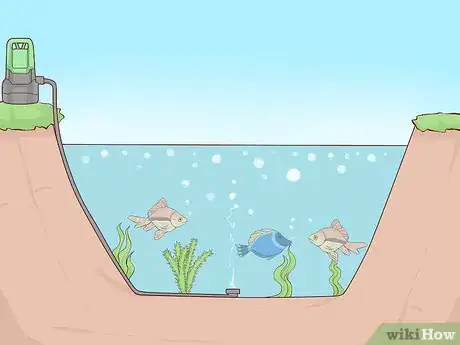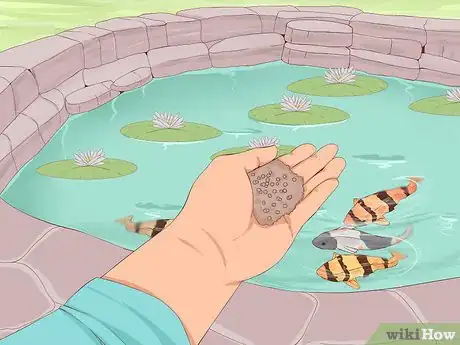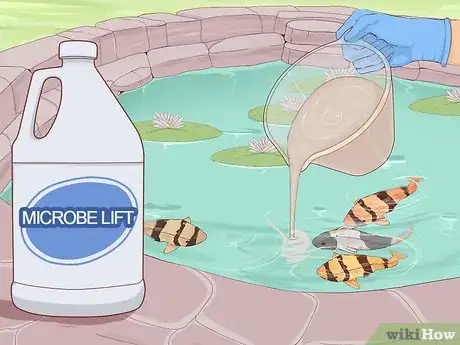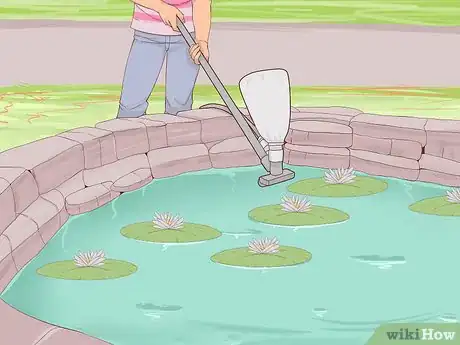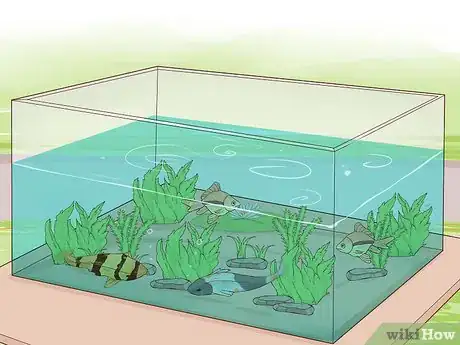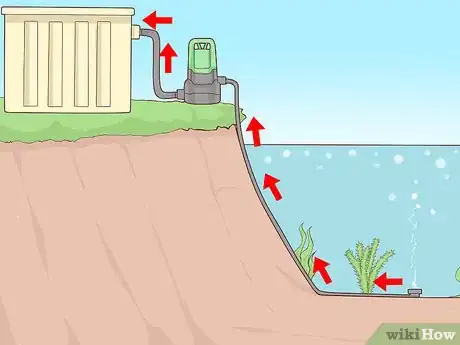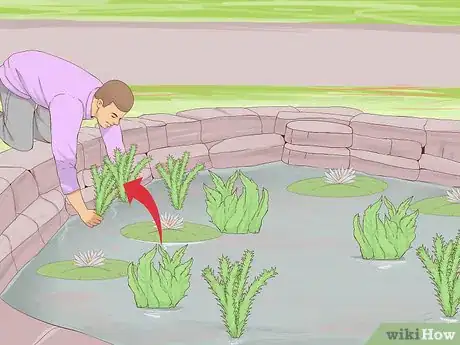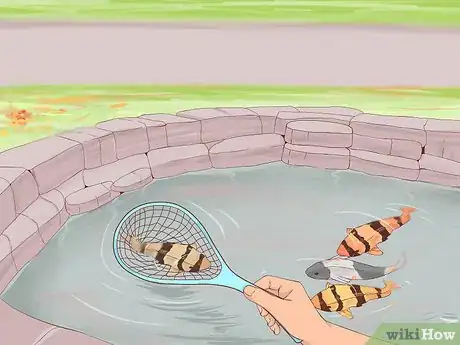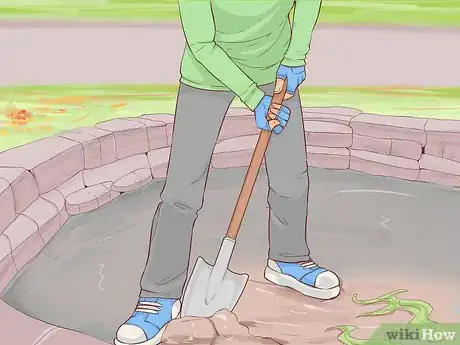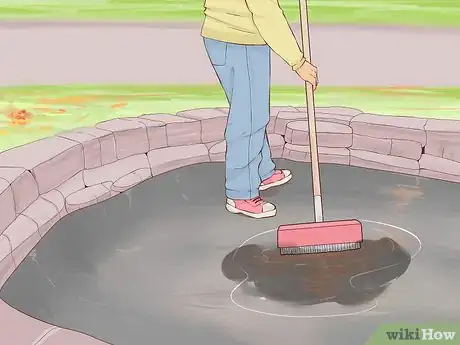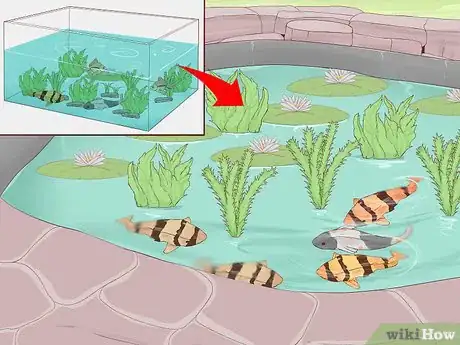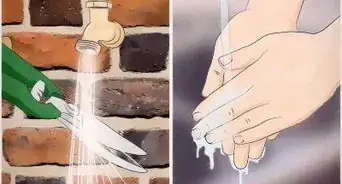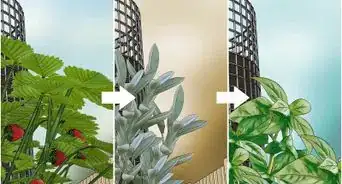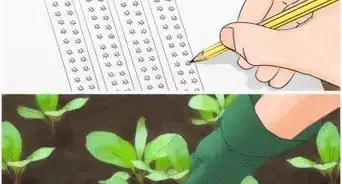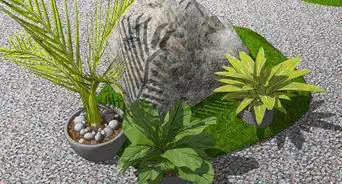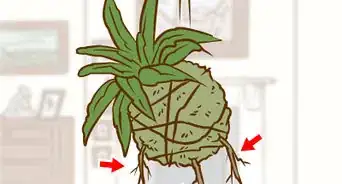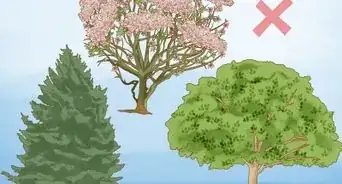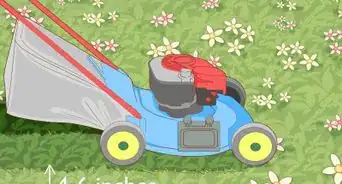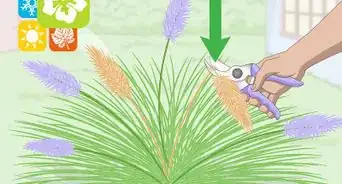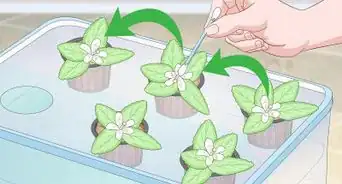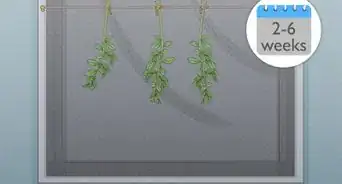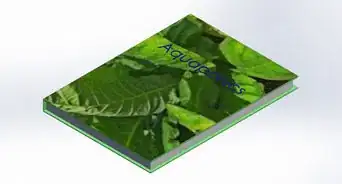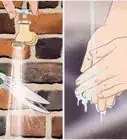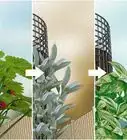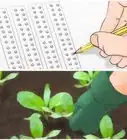This article was co-authored by Lauren Kurtz. Lauren Kurtz is a Naturalist and Horticultural Specialist. Lauren has worked for Aurora, Colorado managing the Water-Wise Garden at Aurora Municipal Center for the Water Conservation Department. She earned a BA in Environmental and Sustainability Studies from Western Michigan University in 2014.
There are 14 references cited in this article, which can be found at the bottom of the page.
This article has been viewed 90,994 times.
Ponds make for beautiful and relaxing natural displays. Yours may have a lovely water fountain or a bunch of koi. However, algae can quickly overwhelm your pond. A single-celled type of algae turns the water green and string algae covers the top of the water. In addition, decaying plant matter leaves a sludge at the bottom of the pond. To clean a pond, fish out string algae, treat the water with hydrogen peroxide or barley straw, maintain the pond with aeration, and remove plant debris with a pond vacuum or by pumping out the water.
Steps
Clearing out Algae
-
1Remove string algae with a brush, net, or your hand. String algae, which looks like strands of hair floating on the water or clinging to the walls, harms the pond’s ecosystem. A scrub brush such as a toilet brush can be used to lift up and remove the algae. Skimming nets from a home improvement store also help reach the algae, but you can also yank out the algae by hand.[1]
- Some string algae is beneficial to the pond’s health. The algae that sticks on the pool liner, as long as its growth is under control, protects fish and combats green water caused by other algae. Try to control the algae using natural maintenance methods such as by adding plants, aerating the water, and removing waste yearly.[2]
-
2Add hydrogen peroxide for quick water treatment. When your pond is very green, hydrogen peroxide may clear up the algae faster. Add about one pint (.48 L) of store-bought hydrogen peroxide for every 1,000 gallons (3785.4 L) of pond water. Dilute it if possible by letting it run with a fountain, waterfall, or other moving water.
- Results will vary between ponds, but you can increase the amount of hydrogen peroxide as needed. Be careful though, because it can harm fish and plants.
- Chemicals such as String Algae Control are less harmful but more expensive options for existing algae problems.
Advertisement -
3Add barley straw for a natural treatment. Purchase barley straw online or at a garden center. Stuff the straw into a mesh bag, hay net, or fishnet tights. Allow the bag to sit in the pond for several weeks, preferably where the water spreads, such as a fountain or waterfall, if possible. After a few weeks, the barley will start to degrade. Remove any rotting pieces to avoid adding more nutrients for the algae.[3]
Maintaining the Pond
-
1Install a UV clarifier. UV lights treat the single-celled algae that causes green water. The UV light is installed in the water. Water passes through the light and the algae gets destroyed. The light needs to be replaced yearly and brought in during winter months.[4]
-
2Rinse your pond filter. Your pond may have a filter, which is useful for growing bacteria that breaks down waste and food when you have lots of fish. If it is difficult for water to flow through the filter, follow the owner’s manual to clean the filter. Only use pond water so that you preserve the helpful bacteria in the filter.[5]
-
3Introduce plants. Plants are a way to naturally keep the pond clean and clear of algae. Plants such as anacharis, hornwort, and parrot’s feather live under the water and keep the water full of oxygen, which limits algae growth. Lilies and lotus plants also cover the surface of the water, blocking sunlight that aids excessive algae growth.
- You introduce plants by planting them at appropriate layers. For example, submerged plants such as anacharis rests fully below the surface with its roots in a basket. Marginal plants, including cattails, and lilies are rooted in water with aquatic potting soil. Floating plants such as water hyacinths rest on the water’s surface.
-
4Supplement aeration with a water pump. Aeration adds oxygen to the water by churning it. Plants, waterfalls, and fountains all help, but you can also add an aeration pump to keep the water mixed, preventing algae and odors.[6]
- Install small pumps by attaching the water recirculating hose and placing the pump in the water away from dirt, such as on a block or rocks. Hide the open end of the hose away from the pump near some rocks. Plug the pump’s power cord into an outlet, making sure it is away from water. You may wish to bury the cord underground in PVC pipe.[7]
-
5Control the amount of food for fish. Uneaten fish food leaves nutrients that cause algae buildup. Either use higher-quality food or rely on natural food such as the algae growing on the pond liner. Don’t offer extra food when it isn’t needed. Monitor the water for leftover food and offer less as needed.[8]
- Feed fish high-protein fish food, such as Pond Care Summer Staple, two to four times a day when the water is warm. Feed them once every day or two days with a low protein food when the water goes below 60 degrees F (15.5 degrees C).
-
6Replenish bacteria in the summer. In winter, the air filter keeps bacteria alive that would otherwise die in the cold. In the summer, algae prevention can be bolstered by adding a product such as Microbe Lift. Follow the directions on the label for the correct dosage.[9]
- Beneficial bacteria breaks down chemicals harmful to fish, such as ammonia, and food and waste nutritious to algae. It will also help balance the microbiome in your pond.
Removing Sediment from a Shrinking Pond
-
1Vacuum out debris with a pond vacuum. Pond vacuums may be found online or at home improvement stores. They have long handles and reach the bottom of the pond to remove decaying plant matter without removing water. If your pond is small or doesn’t have much debris, all you will need to do is vacuum.[10]
- Routine pond cleaning to remove plant matter should be done once a year in spring or fall.
-
2Prepare holding tanks for pond creatures. If you need to drain the water to reach sediment collecting on the bottom, you’ll have to remove the fish and plants to avoid harming them. Set up enough tanks to hold all of them. Keep the tanks in a shady location. Fill them with pond water or, if the pond water is cloudy, tap water.[11]
- Marginal plants, which live near the water’s edge, can survive out of water but must be kept shaded, as with a tarp, and damp, as with a spray bottle or hose.
- Keep the water temperature consistent when transporting any fish so they don't go into shock.
-
3Begin pumping water into a large container. Utility pumps can be found at home improvement stores. Follow the owner’s manual to install them near the water. Connect them by hose to a large container that will hold the pond water, such as a tub or tank. Make the tank as large as possible to hold fish and plants too, if you plan on using this as a holding tank.[12]
-
4Remove plants as the water level drops. As water is removed from the pond, plants will be exposed. Save your plants by moving them to the holding tanks. Place aside decaying plant matter. Small pond creatures may leave the plant matter and return to the pond.[13]
- This is a good opportunity to repot plants and divide others that have begun to take up too much space in the pond.
-
5Catch and remove fish when the water level drops. Fish will also appear as you pump. Use a net to catch the ones you can reach and drop them into holding tanks. Once the water reaches a low level, the fish will have nowhere to go and can easily be scooped up in a net.[14]
- Placing them in a shaded holding tank containing pond water prevents stress that harms the fish.
- Place leaf netting over the holding tanks to contain jumping fish such as koi.
-
6Scoop out plant matter. For ponds that can be managed by hand, the sludge at the bottom of the pond can be removed by sweeping with a broom and dust pan or shovel. Dispose of the waste in the trash.[15]
- Larger ponds with dropping water levels due to sediment buildup may benefit from excavation and bulldozing by a professional.[16]
- Dredging is an option for removing sediment without draining the water, but this requires heavy machinery and the sediment can break apart when moved.
-
7Scrub the pond liner with water. Use a scrub brush dipped in water to loosen any leftover sludge for removal. You may see carpet-like string algae covering the liner. This algae, as long as it is on the liner, protects against discolored water. The only time you should consider removing the algae on the liner is if you don’t like the way it makes your pond look. Otherwise, remove strands on the walls or water’s surface. [17]
- Don’t use chemicals to attack algae, since this harms fish. Blast algae off rocks using a hose and pick up the string variety by hand or with a pole.
-
8Return everything to the pond. Gradually pump water back into the pond, placing plants as you go. When you are finished, let the fish back into the water. For cloudy pond water you wish to replace, use rainwater if possible or dechlorinated tap water.[18]
- Rainwater can be collected by placing barrels under roof downspouts and wherever else you can find runoff.[19]
- Tap water used in the pond will be too cold for the fish, so before you release the fish, remove some water from the holding tank and replace it with some of the new water. Do this several times.[20]
Community Q&A
-
QuestionI have a raised pond and I'm having a problem operating with a pond vac. Can you advise?
 SSSniperduckCommunity AnswerThe best thing you can do for correct and accurate information is to contact the manufacturer/brand and describe your problem to them. They will be able to provide the best advice possible since they know the product, how it works, common problems and most importantly how to fix them quickly and efficiently. Otherwise, you could go on their website and/or have a good look at the instructions to see if you find some more information on what to do.
SSSniperduckCommunity AnswerThe best thing you can do for correct and accurate information is to contact the manufacturer/brand and describe your problem to them. They will be able to provide the best advice possible since they know the product, how it works, common problems and most importantly how to fix them quickly and efficiently. Otherwise, you could go on their website and/or have a good look at the instructions to see if you find some more information on what to do. -
QuestionIf your pond is under a tree, how do you get out the leaves that keep falling?
 cottage goblinCommunity AnswerYou can place a netting over the pond to catch leaves and brush them off every now and again, or you can use a water net and scoop them out daily. You can also hang some netting underneath the underside of the tree, and brush away the leaves daily.
cottage goblinCommunity AnswerYou can place a netting over the pond to catch leaves and brush them off every now and again, or you can use a water net and scoop them out daily. You can also hang some netting underneath the underside of the tree, and brush away the leaves daily. -
QuestionOur pond was there when we moved in and we have no idea how to clean it as there are worms and icky stuff that the previous owners didn't tell us about. It is very annoying in Canada with the coldness!
 cottage goblinCommunity AnswerIn this case, you need to drain the pond first. Next, you can either replace or thoroughly scrub the pond liner so no new germs line up. Then fill up the pond with fresh, clean water. Every week, check on the pond, so this means scooping leaves away with a net and making sure the water isn't getting murky again. Repeat the full process as necessary.
cottage goblinCommunity AnswerIn this case, you need to drain the pond first. Next, you can either replace or thoroughly scrub the pond liner so no new germs line up. Then fill up the pond with fresh, clean water. Every week, check on the pond, so this means scooping leaves away with a net and making sure the water isn't getting murky again. Repeat the full process as necessary.
Warnings
- Fish are very sensitive to changes in the pond, so be careful when introducing tap water or chemicals.⧼thumbs_response⧽
References
- ↑ http://getbusygardening.com/keeping-pond-water-clear-natural-way/
- ↑ http://www.pondtrademag.com/mastering-algae-in-five-steps/
- ↑ http://www.telegraph.co.uk/gardening/how-to-grow/ponds-how-to-keep-your-water-clear/
- ↑ http://www.uvsterilizerreview.com/
- ↑ http://worldofwater.com/pond-filtration-basics/
- ↑ http://www.homehydrosystems.com/articles/What%20size%20pump%20do%20I%20need/What%20size%20pump%20do%20I%20need%20for%20my%20hydroponic%20system.html
- ↑ https://www.thisoldhouse.com/how-to/how-to-create-backyard-pond
- ↑ http://www.peteducation.com/article.cfm?c=16+1917&aid=2259
- ↑ http://pondalgaesolutions.org/2011/08/06/how-to-get-the-most-out-of-pond-bacteria/
- ↑ https://fishponds.biz/vacuums
- ↑ https://www.rhs.org.uk/advice/profile?pid=447
- ↑ https://www.angieslist.com/articles/how-clean-your-backyard-koi-pond.htm
- ↑ https://www.rhs.org.uk/advice/profile?pid=447
- ↑ https://www.angieslist.com/articles/how-clean-your-backyard-koi-pond.htm
- ↑ https://www.angieslist.com/articles/how-clean-your-backyard-koi-pond.htm
- ↑ https://www.bassresource.com/fish_biology/renovating_pond.html
- ↑ http://www.pondtrademag.com/mastering-algae-in-five-steps/
- ↑ https://www.rhs.org.uk/advice/profile?pid=447
- ↑ http://www.gardengatemagazine.com/52droughttolerant/
- ↑ https://www.angieslist.com/articles/how-clean-your-backyard-koi-pond.htm
About This Article
Keeping your pond clean will ensure that it looks fresh and your pond life stays healthy. At least once a year, remove any algae with a brush, net, or by hand. If there’s a lot of algae, consider adding some hydrogen peroxide to get rid of it. You can also introduce plants, like anacharis, hornwort, and parrot’s feather, which produce oxygen and limit the growth of algae. Alternatively, add a water pump to introduce oxygen to the pond. If you have a pond filter, rinse it out regularly to ensure it works properly. Consider getting a pond vacuum for an easy way to clear debris and decaying plant matter from the water. For more tips from our Gardening co-author, including how to remove sediment from a shrinking pond, read on!
